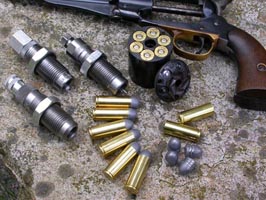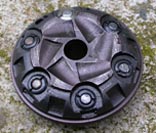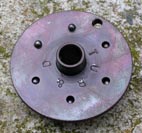Forum
Market
- Nydelig publisert Webley No. 5 Army Express
- Engelsk pattern 1751 infanteri sabel
- Engelsk spadroon
- Smith & Wesson model 2.
- Kjøper Engelske millitære flintlåsvåpen
- " Hevarm " til Kongsberg kammerlader
- Norsk brukt Husqvarna RB selges
On this day
27 October 1870
Marshal François Achille Bazaine and 140,000 French soldiers surrendered to Prussian forces at the end of the siege of Metz. This was one of the biggest French defeats in the Franco-Prussian War, where the French were armed with modern Chassepot... Read more ...
Major French defeat at Metz
Marshal François Achille Bazaine and 140,000 French soldiers surrendered to Prussian forces at the end of the siege of Metz. This was one of the biggest French defeats in the Franco-Prussian War, where the French were armed with modern Chassepot needle guns and Prussians with their Dreyse needle guns.
After a series of French defeats in the opening phase of the war, nearly half of the French force were surrounded at Metz. The newly established French rescue force was crushed in a battle at Sedan, in which the French emperor Napoleon III surrendered to the Germans. This led to the founding of the Third French Republic.
After the German forces conquered Paris, the war ended with an overwhelming German victory and Germany was united under Prussian leadership.

Chat
Offline
No chatting right now.
(You must be logged in to the forum to chat.)
Featured article

The Springfield Trapdoor rifle was a result of the need of the US Army for a breech-loader that could be fired with metallic cartridges. The plans to adopt a breech-loading infantry rifle were started as during the Civil War (1861-65), and gunsmiths from all over the world were invited to submit suggestions for a new rifle mechanism. This is the story of the Springfield Trapdoor.
The Springfield Trapdoor Rifle
R&D Conversion Cylinders
 About
About Les artikkel på norsk
Les artikkel på norsk
The years following the American Civil War was a time of unrest and upheaval, and a time that saw a transition from the percussion system to metallic cartridges. Percussion revolvers, also known as cap and ball revolvers, were made by the thousands before and during the war, but the principle of muzzleloading started to become obsolete when the new metallic cartridges became common after the war.
Find out more!
You can learn more about metallic cartridge conversions and black powder cartridge revolvers in the brand new book From Musket to Metallic Cartridge: A Practical History of Black Powder Firearms.
The cap and ball revolvers could easily be converted to use the new metallic cartridges. In the 1800s there were many methods for converting percussion revolvers. Some variants even allowed the shooter to use both the old percussion cylinder and a new cartridge cylinder. Many patents were based on the old percussion cylinder, in which a chamber was bored out for the cartridges. At the rear where the percussion nipples are located, it was made some sort of device that facilitated the chambering of the metallic cartridges. The R&D conversion cylinders consist of two parts: a cylinder and a back plate with six individual firing pins. The cylinder must be removed from the revolver to be loaded. In the cylinder I use in my .44 Remington New Army, six cartridges are slipped into the cylinder, and the back plate is placed over the cylinder. There is an indexing pin in the body so that the firing pins align properly with the chambers in the cylinder. The cylinder and back plate is then inserted back into the revolver. This may seem a bit cumbersome, but it is way faster compared to loading a percussion revolver. The percussion revolvers could be loaded with paper cartridges, but they tended to get wet and spoiled by moisture. This problem was as good as eliminated with metallic cartridges.
Today the conversion cylinders for replica cap and ball revolvers have become popular among black powder shooters. The R&D cylinders are available for the most common replica revolvers. The cylinder that I use in my .44 Uberti Remington New Army is in .45 Colt (Long Colt). Another alternative is the Kirst Koverter cylinders. These cylinders only take five cartridges, but they have a loading gate that eliminates the need to remove the cylinder to reload. Kirst Konverter cylinders are somewhat more expensive compared to the R&D cylinders.
So far the accuracy from the R&D cylinder has been very good, as a matter a fact it seems to shoot just as well as the percussion cylinder. I have had best results with roundballs, but it also performs well with Lee's .456" conical ball which is designed for percussion revolvers. I size the balls to .454". Only top grade, certified steel is used in the production of these cylinders, and the manufacturer states that is possible to use light smokeless loads in the R&D cylinder, but I haven't tried it and I have no intentions of doing it either. In a revolver that is made for black powder I feel it is more appropriate and safe to stick to black powder.
The conversion cylinders are allowed in the metallic cartridge competition Smith and Wesson when competing in competitions held by the Norwegian Black Powder Union. Some shooters use the R&D cylinders with very good results. Most shooters load the cartridges with roundballs, and they even grease the cylinder mouths the same way as many cap and ball revolver shooters do. With a R&D cylinder you only need one revolver to shoot both in the Mariette (the percussion revolver competition) and the Smith & Wesson competition.
Here's a small video of how the R&D cylinder works:
The R&D cylinders are available for:
.44 calibre- Pietta Remington New Army
- Pietta 1860 Army Colt
- Uberti Remington New Army
- Uberti Dragoon Colt
- Uberti 1860 Army Colt
- Ruger Old Army
- Pietta Remington New Model Navy
- Pietta 1851 Navy Colt
- Pietta 1861 Navy Colt
- Uberti Remington New Model Navy
- Uberti 1851 Navy Colt
- Uberti 1861 Navy Colt
- Uberti Colt 1862 Police
- Pietta 1863 Pocket Remington








